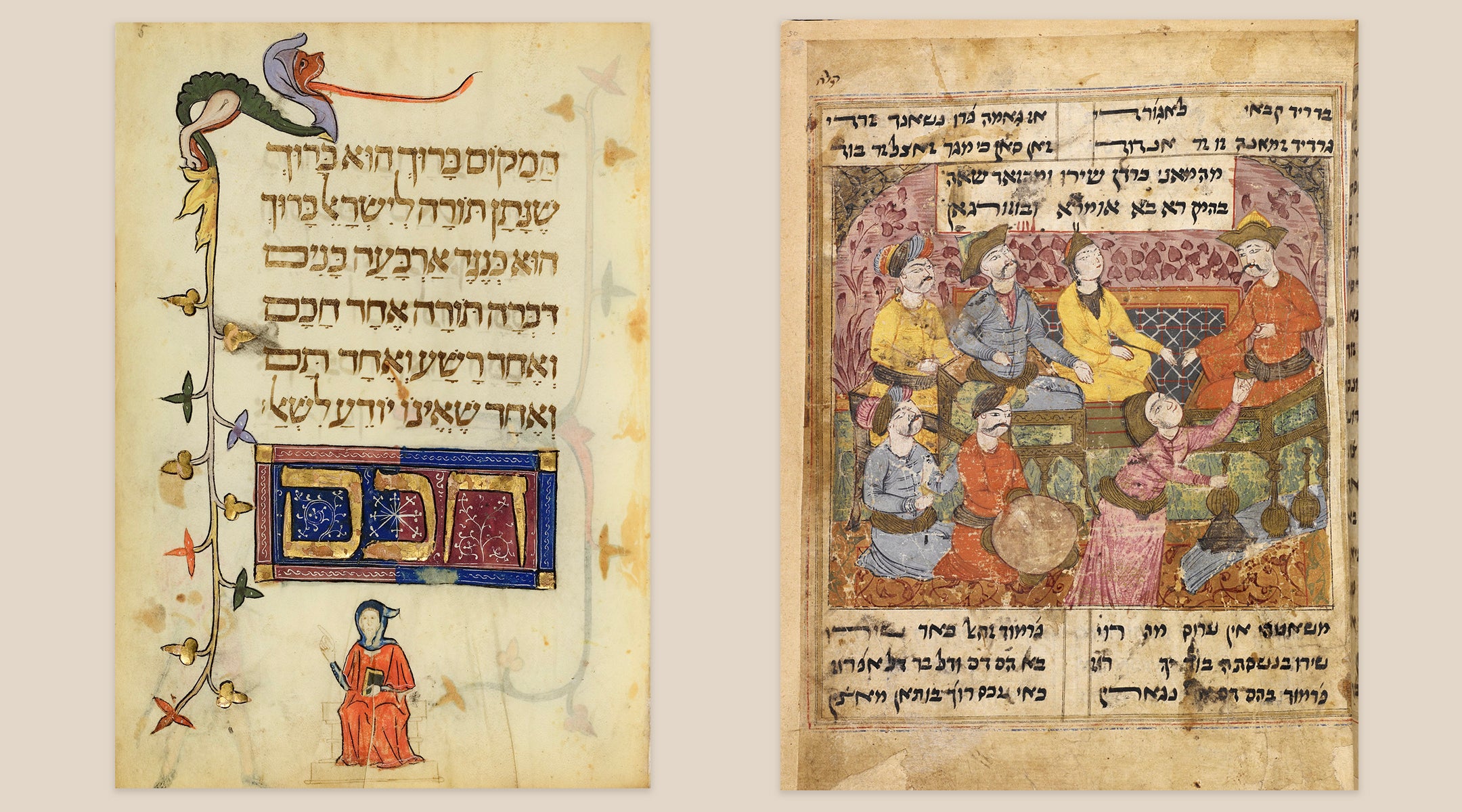On the left side of the ground-floor gallery at the Upper East Side’s Grolier Club — an institution that bills itself as “America’s oldest and largest society for bibliophiles” — you’ll find elaborately decorated, centuries-old Jewish manuscripts from the likes of Italy, France and the Iberian Peninsula.
On the right, there’s a similar assortment of manuscripts, also organized geographically. These manuscripts are remnants of dynamic Jewish communities that once existed in Muslim lands such as Yemen, North African and Iran/Iraq.
Collectively, these works form “Jewish Worlds Illuminated: A Treasury of Hebrew Manuscripts from The JTS Library,” the first-ever exhibition dedicated to Jewish books and manuscripts at the storied club, which was founded in New York City in 1884.
On view through Dec. 27, the free exhibit is also the largest exhibition to date curated by the library of the Jewish Theological Seminary, which is home to one of the world’s largest collections of Hebrew manuscripts and printed materials. Among the 100 objects on view are documents that date as far back as the 12th century.
The elaborately decorated works on display comprise a wide assortment of texts, such as prayer books, Passover haggadahs and ketubahs or Jewish marriage contracts. Most of them are written in Hebrew. But there are some stark differences between the two sides of the gallery: Human forms are plentiful in the manuscripts from Europe, for example, while works created by Jews in Muslim lands typically reflect the Islamic art style, with elaborate patterns, floral motifs and very few depictions of people.
“Jews adopted and adapted the art of the country in which they lived,” Sharon Lieberman Mintz, curator of Jewish art at the JTS library, explained during a private tour. “When Jews were living in Islamic lands, they eschewed figural arts. There may have been a bird or two here and there, but not humans, with rare exception.”
Examples like these spotlight the ways Jews lived their lives throughout years of diaspora, and how they integrated themselves within their culture of residence.
“If you look at the outstanding works in our collection — manuscripts in particular, but not just manuscripts — [they] reflect the geographical distribution that you see here,” said David Kraemer, the Joseph J. and Dora Abbell librarian and professor of Talmud and Rabbinics at the JTS. “It is notable, but not intentional, that we don’t have material here from the land of Israel.”
Kraemer continued: “What that means is that during the ages that these works were being produced, and from which they survive, this is where Jews lived,” he said. “Very, very few Jews lived in the land of Israel, and there was very little production of this kind of material in the land of Israel.”
Left: Abraham Judah ben Yehiel of Camerino’s “Rothschild Mahzor,” from Florence, Italy in 1490. Right: A page from “Sermons and Collected Teachings,” from 17th-century Salonica, Greece. (Courtesy the Library of the Jewish Theological Seminary).
Instead, the exhibit is filled with treasures from across the centuries and around the globe, including handwritten letters from the physician, rabbi, philosopher and author Moses ben Maimon — aka Maimonides. One such letter, penned in 1170 by Maimonides’ personal secretary, Mevorakh ben Nathan, is signed by the sage himself. It pleads for funds to ransom the Jews who were taken prisoner in November 1168 when the crusader king Amalric I of Jerusalem conquered the Egyptian city of Bilbeis, some 50 miles north of Cairo, which was home to a sizable Jewish community in the Middle Ages.
“So much of what happens, Jewishly, in North America is Ashkenazi-centric, which misrepresents Jewish life and history around the world,” Kraemer said. “When Ashkenaz was barely a blip, the vast majority of the world’s Jews lived in Muslim lands.”
The exhibit makes it plain just how embedded Jews were into the countries in which they lived. In the Italy section, there’s a page displayed from the Rothschild Machzor, a prayer book written by master scribe Abraham Judah ben Yehiel in Florence in 1490. An illustration depicts the children of Israel receiving the Ten Commandments as they’re decked out in the Florentine fashions of the time — with the receding hairline that was all the rage in during the Renaissance.
“When you look at these materials, you can’t just think of Jews as separated and isolated and ghettos and oppressed and all that kind of stuff,” Kraemer said. “That’s not what the story here is.”
Instead, the exhibit spotlights how Jewish communities reflected broader cultural trends, including fashion and art.
Just don’t ask the curators to select their favorites. Kraemer and Liberman Mintz both blanched when asked to choose three or four standout items in the gallery. Instead, we settled on finding particularly unusual works on display.
“The answer changes every five minutes,” Kraemer explained.
As an example, Kraemer points to a 17th-century manuscript from Salonica, Greece that he describes as “absolutely wonderful in its outrageous combination.” The page, from a collection of sermons and teachings, is a scholarly theological discussion — specifically, about how Moses, who was flesh and blood, was able to ascend to the realm of God, who is pure spirit. By contrast, the illustrations on the page — animals, birds and flowers — seem like something from a children’s book.
“Don’t we all somehow have those sensibilities built into us?” Kraemer mused. “We can be very, very sophisticated and very, very simple and childlike at the same time.”
All told, the exhibit, said Kraemer, is meant to challenge misconceptions about how Jews lived their lives during centuries of diaspora life.
“We have a lot of conceptions of what Jewish life was through the ages,” Kraemer said. “When one witnesses these materials — their splendor, their creativity, their embeddedness within the local culture, their languages, the visual language, all of that — it tells us that Jews and their neighbors were part of the same world.”
“In a world which has a very black and white vision of Jewish life and the relationship of Jewish life to the host cultures, this brings color to it,” Kraemer continued. “It wasn’t black and white. I mean both literally and figuratively — this brings color to the fullness of Jewish experience.”
“Jewish Worlds Illuminated: A Treasury of Hebrew Manuscripts from The JTS Library” is on view at The Grolier Club (47 East 60th St.) through Dec. 27. For more information, click here; to book a tour (highly recommended!) click here.
Jewish stories matter, and so does your support.




